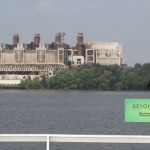 By Peter Galuszka
By Peter Galuszka
For Northern Virginians who love the Potomac River, sailing out of the Washington Sailing Marina just south of Reagan National Airport is a special treat.
From little boats, sails flapping in the wind, they can see the broad sweep of the D.C. and Alexandria waterfront: the Jefferson Memorial, Memorial Bridge , Hains Point, bits of the Georgian architecture of Old Town Alexandria and, of course, the five, low-rise smokestacks of the GenOn coal-fired power station.
The power plant has been working for 63 years, providing electricity to the Capital region and beyond. It had been the single largest source of air pollution in the DC area for years. It has just shut down permanently, thanks mostly to energy economics. Natural gas has made it too expensive to keep operating coal dinosaurs such as GenOn’s Potomac River Generating Station.
It will be a hard pull for Mitt Romney and other Republican politicians to claim that GenOn’s plant is a victim of the “War on Coal.” It isn’t really Barack Obama who is closing such plants, it is free market economics.
According to the Christian Science Monitor, the flood of natural gas brought on by hydraulic fracking methods is taking a serious toll of coal, which used to represent 45 percent of all electricity power generation in the U.S. It is now expected to fall to 39 percent by 2035, still a significant factor in power generation.
“While gas-fired power plants are popping up like dandelions across America, just one coal-fired generator was brought in in the first half of 2012, the Energy Information Agency Reports,” says the Monitor. As gas-fired plant sprout, old coal-fired ones fade away. Since 2010, utilities have announced the retirements of 12 percent of the nation’s coal-fired generating capacity. More immediately, in the PJM grid that covers people from Delaware to Illinois, gas plants run about half the time, instead of 15 percent a decade ago.
Dominion Virginia Power is expected to shut down units at its ancient Chesapeake and Yorktown coal-fired plants. Meanwhile, it has opened a new one near the coal-fields town of St. Paul that can burn coal, “gobs” of leftover coal or tree trunks. Speaking of Dominion, however, environmental activists are expected to launch a nearly week-long series of protests in Richmond against the utility for taking advantage of a $76 million benefit that is supposed to push the utility into renewable energy forms.
A 2007 law sets up a “Renewable Energy Portfolio Standard (RPS) that supposedly would increase the percentage that renewable energy forms play a utility’s overall mix. Five years ago, the idea was that Dominion would be erecting huge wind and solar farms, but that hasn’t happened, supposedly because of the expense. Meanwhile, Dominion has taken $76 million in credits by buying them from other states and using some existing facilities to conform to the RPS standard.
While green activists say that Dominion is gaming the system at ratepayers’ expense, other groups, such as the Southern Environmental Law Center say that the chief problem is a badly-written and unclear law.
Whatever happens with the renewable standards, the economic trend against coal-fired electricity generation is clear. New technologies to further reduce emissions and capture carbon are best erected onto new, greenfield coal-fired plants. But business dictates that they aren’t being built because they are too expensive – some think that is really hard to lay at Obama’s feet. As for GenOn, the plant will eventually turn into a waterfront, mixed-use development.


